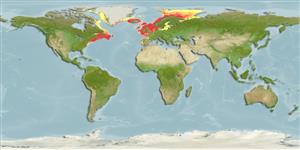Preferred temperature (Referencia
123201): 1.4 - 12.1, mean 8.4 °C (based on 1651 cells).
Phylogenetic diversity index (Referencia
82804): PD
50 = 1.0000 [Uniqueness, from 0.5 = low to 2.0 = high].
Bayesian length-weight: a=0.00661 (0.00582 - 0.00750), b=3.08 (3.04 - 3.12), in cm total length, based on LWR estimates for this species (Ref.
93245).
Nivel trófico (Referencia
69278): 4.0 ±0.1 se; based on diet studies.
Generation time: 5.0 (4.6 - 5.6) years. Estimated as median ln(3)/K based on 36
growth studies.
Resiliencia (Referencia
120179): Medio, población duplicada en un tiempo mínimo de 1.4-4.4 años (rm=0.54-1.2; K=0.12-0.30; tm=2-6.5; tmax=20; Fec=100,000).
Prior r = 0.50, 95% CL = 0.33 - 0.75, Based on 41 full stock assessments.
Fishing Vulnerability (Ref.
59153): Moderate to high vulnerability (55 of 100).
🛈
Climate Vulnerability (Ref.
125649): Moderate vulnerability (40 of 100).
🛈
Nutrients (Ref.
124155): Calcium = 10.2 [3.2, 40.2] mg/100g; Iron = 0.175 [0.075, 0.825] mg/100g; Protein = 18 [16, 20] %; Omega3 = 0.617 [0.316, 1.243] g/100g; Selenium = 32.9 [12.1, 89.8] μg/100g; VitaminA = 7.92 [2.06, 29.85] μg/100g; Zinc = 0.309 [0.168, 0.623] mg/100g (wet weight); based on
nutrient studies. 